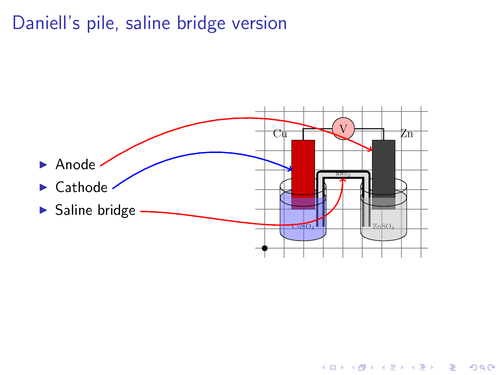With PGF 1.09 and later, it is possible to draw paths between nodes across different pictures. In this example I have used this feature to connect text with coordinate nodes placed on a picture. The picture is loaded from an external file A background grid is used to make it easier to place the coordinates manually.
Note. This only works with PDF(La)TeX, and you have to run PDFTeX twice.
Source: Inspired by a post to the latex-beamer-users list. The Daniell's pile illustration is made by Augustin E. Bolzan.

Edit and compile if you like:
% This example requires PGF >= 1.09 and only works wit PDFTeX
% You have to compile document twice to get correct placement of nodes.
\documentclass{beamer} %
\usepackage{tikz}
\usetikzlibrary{arrows,shapes,backgrounds}
\begin{document}
% For every picture that defines or uses external nodes, you'll have to
% apply the 'remember picture' style. To avoid some typing, we'll apply
% the style to all pictures.
\tikzstyle{every picture}+=[remember picture]
\tikzstyle{na} = [baseline=-.5ex]
\begin{frame}
\frametitle{Daniell's pile, saline bridge version}
\begin{columns}
\begin{column}{0.4\paperwidth}
% define source coordinates
\begin{itemize}
\item Anode \tikz[na] \coordinate (s-anode);
\item Cathode \tikz[na] \coordinate (s-cathode);
\item Saline bridge \tikz[na] \coordinate (s-bridge);
\end{itemize}
\end{column}
\begin{column}{0.45\paperwidth}
% Use a background grid to make it easier to find coordinates
% When the coordinates have been found, remove the
% 'show background grid' option.
\tikzstyle{background grid}=[draw, black!50,step=.5cm]
\begin{tikzpicture}[show background grid]
% Put the graphic inside a node. This makes it easy to place the
% graphic and to draw on top of it.
% The above right option is used to place the lower left corner
% of the image at the (0,0) coordinate.
\node [inner sep=0pt,above right]
{\includegraphics[width=4cm]{img/daniells-pile}};
% show origin
\fill (0,0) circle (2pt);
% define destination coordinates
\path (0.7,2) coordinate (cathode)
(2,1.8) coordinate (bridge)
(2.75,2.5) coordinate (anode);
\end{tikzpicture}
\end{column}
\end{columns}
% define overlays
% Note the use of the overlay option. This is required when
% you want to access nodes in different pictures.
\begin{tikzpicture}[overlay]
\path[->,red,thick] (s-anode) edge [bend left] (anode);
\path[->,blue,thick] (s-cathode) edge [bend left] (cathode);
\path[->,red,thick] (s-bridge) edge [out=0, in=-90] (bridge);
\end{tikzpicture}
\end{frame}
\end{document}Click to download: connecting-text-and-graphics.tex • connecting-text-and-graphics.pdf
Open in Overleaf: connecting-text-and-graphics.tex


